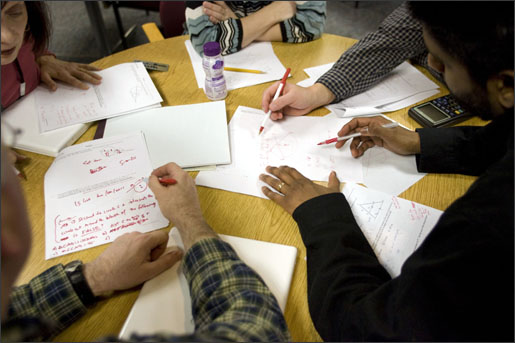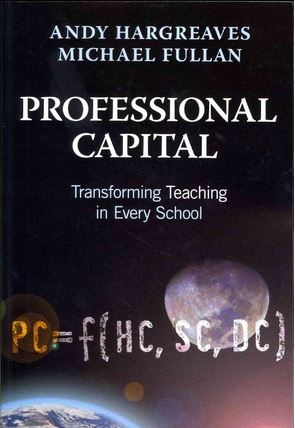“Another turning point, a fork stuck in the road”
So the lyrics of Green Day’s song “Good Riddance (I hope you had the time of your life)” start.
I didn’t actually set off to write this post but recently a number of posts, I have written, link to the idea of Professional Capital which some people are familiar with and others less so. I thought it might be helpful to summarise the ideas behind Professional Capital and the opposing model of Business Capital for future reference.
The type of capital you would advocate is a fork in the road, you have to decide which path to travel, they are divergent and there is no fence to sit on.
The graphic below I often used to describe leadership and in particular developing leadership clarity. If you are leading you have the Authority to make decisions, particularly the final decision, there is Accountability in terms of consequences for the success or failure of the outcome and you have the Capacity (Capital) to get the job done. Without the correct capital, in place at the right time, you will be left exposed as a leader and unable to get the job done. How often do we seek to implement an idea or strategy without assessing that the necessary capacity or capital is in place?
With recent changes putting increased autonomy for schools into the education system the authority to make decisions and the accountability for them sits to a greater extent with headteachers, principals, governors and academy boards. Building capacity (capital) into the system to ensure this autonomy is used in an informed, coherent and morally acceptable way that benefits all students in all our schools is a key issue for us to determine. Without the clear vision and drive to make this decade the one of Professional Capital many of the new autonomies will fall onto arid ground and the hoped for improvements within the education system will not be realised.
The Work of Andy Hargreaves & Michael Fullan
“Capital relates to one’s own group or worth, particularly concerning assets that can be leveraged to accomplish desired goals.”
(Hargreaves & Fullan, 2012)
The information below are taken from Andy Hargreaves’ presentation at the SSAT’s Redesigning Schools Symposium in Manchester in March 2013. The presentation was based on Andy Hargreaves and Michael Fullan’s excellent book titled “Professional Capital”. To understand the education system and direction of travel I would suggest it is one of those must read books.
The Business Capital Model
The current business capital model sees teaching as a very simple process that doesn’t require much beyond a degree and passion, it is the basis for increasing use of unqualified teachers in the classroom. It’s not hard and can be picked up quickly. Online courses are equally effective as teachers but more efficient. The process is data driven – spot the gap and sort it. Business Capital view assumes that good teaching:
- Is technically simple
- Is a quick study
- Can be mastered readily
- Should be driven by hard performance data
- Is about enthusiasm, effort, talent, & results
- Is replaceable by online instruction
The Professional Capital Model
Professional Capital view assumes that good teaching:
- Is technically sophisticated and difficult
- Requires high levels of education & long training
- Is perfected through continuous improvement
- Involves wise judgment informed by evidence and experience
- Is a collective accomplishment and responsibility
- Maximizes, mediates & moderates online instruction.
Hargreaves & Fullan (2012) explain their formula for transforming teaching, PC = f (HC, SC, DC), as the fusion of human capital, social capital and decisional capital that together combine to produce professional capital.
HUMAN CAPITAL
This consists of the qualifications, knowledge, preparation, skills and emotional intelligence of the people employed within schools.
The “solutions” to achieving higher human capital are:
- Recruit from the top academic tiers
- Select for moral commitment & emotional intelligence
- Rigorous preparation in theory & practice
- Take pay off the table
- Attractive working & collegial environment
- Talk up teaching as a profession
Human Capital is about getting the best possible people into teaching. However, that is not enough as the best possible people working in isolation will either become disillusioned at the scale of the challenge or burnout. The more that is needed brings in the idea of social capital.
SOCIAL CAPITAL
Social capital exists in the relationships between people. Its positive impact is explained through the quantity and quality of social relationships and interactions that increases trust, collaboration, collective responsibility, mutual assistance, professional networks and a bit of push, pull and nudge (different leadership approaches)

Photo credit: http://www.edweek.org
The solutions to achieving higher social capital are:
- Deep professional learning communities
- School networks & helping relationships
- Collective responsibility across year groups, key stages and schools
- Shared language
- Collaborative tools
- Peer assisted review
- Collective rewards
Human Capital is about connecting people. Great people working together and increasing their skills and knowledge is fantastic but it is how we put all this capital together for the benefit of the students we teach that puts the final piece in the jigsaw – decisional capital is required.
DECISIONAL CAPITAL
This consists of the judgement we show, case experience, practice, challenge & stretch and reflection. It is about how we develop wisdom (good judgement) over time that enables us to become more and more capable within our chosen vocation of teaching.
The solutions to increasing decisional capital are:
- 10,000 hours of deliberate practice
- Stimulating & challenging new experiences
- Mentoring & coaching
- Enquiry projects
- Alternative & flexible career paths
- Targeted career progression
- Sabbaticals and study leave
The Final Word Goes to Green Day
“It’s something unpredictable
But in the end is right
I hope you had the time of your life”
Teaching is not predictable, you never know what might happen when you walk into a class of thirty young people or what has happened in their lives overnight, over the weekend or over the holidays but that is partly why we love it. It is also why teaching requires highly capable, skilled, connected and trained people. I love working in education and schools but if I am to have the time of my life then I need to work in a professional capital system which values, challenges and develops me. What about you?






Reblogged this on Primary Blogging.
Posted by primaryblogger1 | January 4, 2014, 5:38 pm